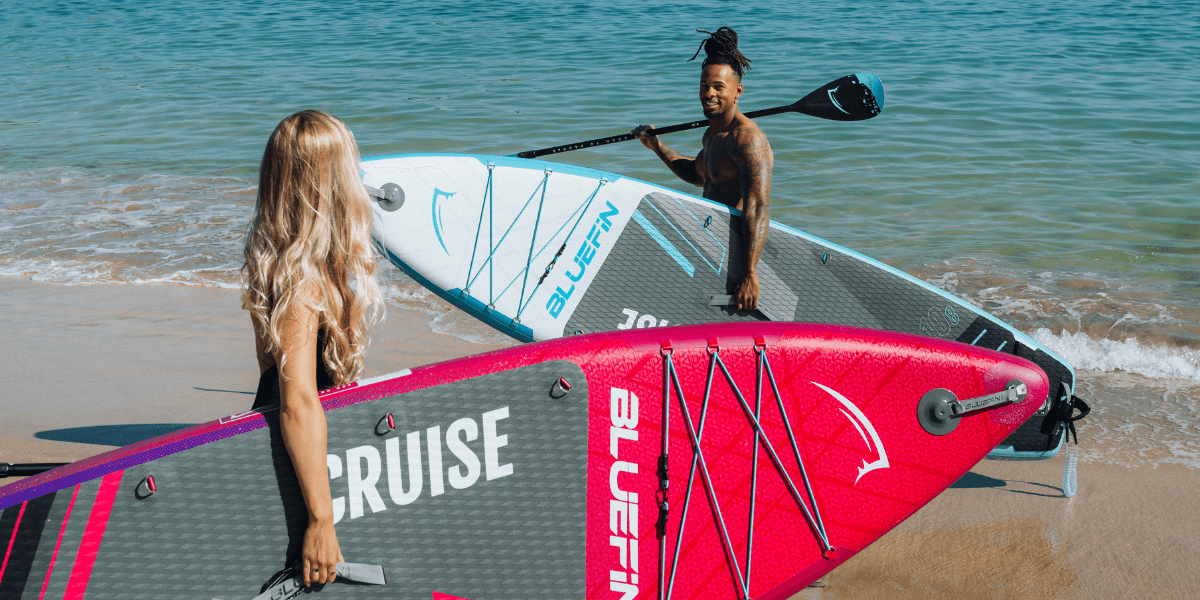
Embarking on a SUP adventure is so thrilling that it’s often forgotten that paddleboarding is an actual sport! And being an inclusive sport at that, paddleboarding is loved for being suitable for all the family, no matter your age or ability.
To ensure that you’re always working out safely and correctly – and let’s be honest, we all want to reap the incredible health benefits of the low impact, full-body exercise that a paddle provides – it’s essential that your SUP technique is just right.
So, we’re giving you a few basic SUP technique tips that’ll have you paddling at your very best!
Positioning yourself on your board
Once you’ve mastered the basics of standing up and staying up on your paddleboard, it’s time that you’re standing up correctly on your paddleboard.
So let’s begin: Standing up straight, feet shoulder-width apart, knees slightly bent and your back straight. It’s also important that you’re positioned in the middle of the paddleboard at all times.
By keeping your knees slightly bent, you’ll gain greater stability and balance over your board, as your knees act as ‘shock absorbers’ to any oncoming waves. By maintaining a straight back, you’ll ensure that your core muscles stay engaged. This then allows you to paddle from your core and not just your arms, giving you more power and reducing muscle strain or injury. Protect the knees!
Catching the water with your paddle
The main SUP technique tip to remember here is that your paddleboard should always move past your paddle. You should aim to move forwards with each stroke of your paddle.
The start of each stroke, where your paddle’s blade enters the water, is called the ‘catch’. Think of it as ‘catching the water,’ to push yourself forward with each stroke.By keeping your blade horizontal to the water, your paddle will enter the water easily and will be in the perfect position to push against the optimal amount of water resistance to move you forwards.
Top SUP technique tip: the ideal amount to enter your paddle into the water is to have the blade completely submerged. The paddle’s handle should always stay above water, giving you added stability and control of your paddling.

Improving your SUP technique to move through the water
By keeping two hands on the paddle at all times, you’ll gain greater movement across the water, and also receive an incredible upper body workout! Depending on your paddling side, you’ll need to adjust your hand positioning accordingly. We suggest that you paddle on both sides of your body equally, so that you exercise ALL of your muscles.
If you’re paddling on the right side of the board, you’ll need to position your right hand halfway down your paddle with your left arm at the top to create ‘stacked hands’. If you’re paddling on the left, it should be the other way round – makes sense, right?
This stacked hands approach will ensure maximum power with minimum energy output with each stroke! How’s that for an effective SUP technique?
Stability, A SUP Technique Essential
You should insert the paddle in front of you within a comfortable reach and end the stroke at your feet. This guarantees that you don’t lean too far forwards or backwards, preventing you from losing your footing and splashing into the water!
The paddle’s entry and exit of the water are controlled by your hand at the top of the paddle.
To reduce wobbling significantly, keep your knees bent, making it easier to dip slightly as you insert your paddle into the water. This will give you more grounding as you stay closer to your paddleboard. It also keeps your leg muscles engaged by giving them a low-impact workout! It’s a win-win!
But take note, if conditions suddenly change, we recommend you lower your lower hand and bend your knees more. This ensures that you’re closer to the paddleboard, giving you greater control and making it easier to paddle to safety. After all, our SUP technique tips are for you to have the most enjoyable and safest experiences.
We hope these tips assist you in perfecting your SUP technique so that you’re always paddling effectively wherever you’re exploring. Whether you’re new to paddleboarding or are a seasoned pro out on the waters, it’s still worth spending a few moments checking that you’re paddling at your very best.


Share:
How To Store Your Paddle Board In Winter
Swap the Gym for your SUP!